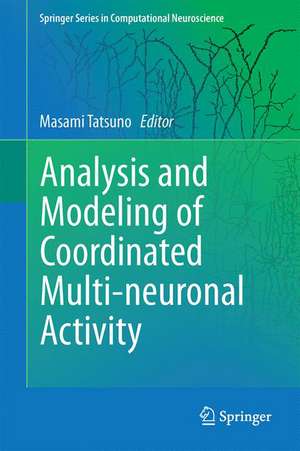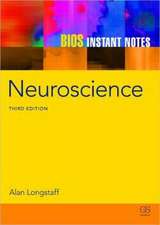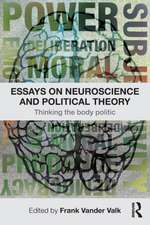Analysis and Modeling of Coordinated Multi-neuronal Activity: Springer Series in Computational Neuroscience, cartea 12
Editat de Masami Tatsunoen Limba Engleză Hardback – 14 noi 2014
| Toate formatele și edițiile | Preț | Express |
|---|---|---|
| Paperback (1) | 565.82 lei 38-44 zile | |
| Springer – 10 sep 2016 | 565.82 lei 38-44 zile | |
| Hardback (1) | 650.04 lei 6-8 săpt. | |
| Springer – 14 noi 2014 | 650.04 lei 6-8 săpt. |
Din seria Springer Series in Computational Neuroscience
-
 Preț: 386.39 lei
Preț: 386.39 lei - 18%
 Preț: 954.62 lei
Preț: 954.62 lei - 24%
 Preț: 1173.18 lei
Preț: 1173.18 lei - 23%
 Preț: 1342.27 lei
Preț: 1342.27 lei - 18%
 Preț: 1124.78 lei
Preț: 1124.78 lei - 18%
 Preț: 957.13 lei
Preț: 957.13 lei - 5%
 Preț: 1424.89 lei
Preț: 1424.89 lei - 18%
 Preț: 1219.63 lei
Preț: 1219.63 lei - 18%
 Preț: 961.72 lei
Preț: 961.72 lei - 15%
 Preț: 648.56 lei
Preț: 648.56 lei - 18%
 Preț: 1379.21 lei
Preț: 1379.21 lei - 18%
 Preț: 951.77 lei
Preț: 951.77 lei - 18%
 Preț: 1217.75 lei
Preț: 1217.75 lei - 5%
 Preț: 1411.90 lei
Preț: 1411.90 lei - 18%
 Preț: 1228.29 lei
Preț: 1228.29 lei - 18%
 Preț: 1224.68 lei
Preț: 1224.68 lei - 18%
 Preț: 1224.85 lei
Preț: 1224.85 lei - 18%
 Preț: 949.73 lei
Preț: 949.73 lei
Preț: 650.04 lei
Preț vechi: 764.76 lei
-15% Nou
Puncte Express: 975
Preț estimativ în valută:
124.40€ • 129.40$ • 102.70£
124.40€ • 129.40$ • 102.70£
Carte tipărită la comandă
Livrare economică 15-29 aprilie
Preluare comenzi: 021 569.72.76
Specificații
ISBN-13: 9781493919680
ISBN-10: 1493919687
Pagini: 354
Ilustrații: X, 354 p. 76 illus., 59 illus. in color.
Dimensiuni: 155 x 235 x 20 mm
Greutate: 0.69 kg
Ediția:2015
Editura: Springer
Colecția Springer
Seria Springer Series in Computational Neuroscience
Locul publicării:New York, NY, United States
ISBN-10: 1493919687
Pagini: 354
Ilustrații: X, 354 p. 76 illus., 59 illus. in color.
Dimensiuni: 155 x 235 x 20 mm
Greutate: 0.69 kg
Ediția:2015
Editura: Springer
Colecția Springer
Seria Springer Series in Computational Neuroscience
Locul publicării:New York, NY, United States
Public țintă
GraduateCuprins
Part I. Method of Multi-Electrode Recording.- Chapter 1. Techniques for Large-Scale Multiunit Recording.- Chapter 2. Silicon Probe Techniques for Large-scale Multiunit Recording.- Part II. Coordinated Neural Activity in Rodent Hippocampus and Associated Areas.- Chapter 3. Overview of Neural Activity in the Awake and Sleeping Hippocampus.- Chapter 4. Associative Reactivation of Place-Reward Information in the Hippocampal-Ventral Striatal Circuitry.- Chapter 5. Hippocampal Sequences and the Cognitive Map.- Chapter 6. Reorganization of Hippocampal Place-Selective Patterns During Goal-Directed Learning and Their Reactivation During Sleep.- Chapter 7. Causal Relationship Between SPW-Rs and Spatial Learning and Memory.- Part III. Cortical Neural Activity and Interaction with the Hippocampus.- Chapter 8. Packets of Sequential Neural Activity in Sensory Cortex.- Chapter 9. Coordinated Sequence Replays Between the Visual Cortex and Hippocampus.- Chapter 10. Memory Consolidation, Replay, and Cortico-Hippocampal Interactions.- Part IV. Memory Reactivation in Humans.- Chapter 11. Memory Reactivation in Humans (Imaging Studies).- Part V. Computational Modeling of Coordinated Neural Activity.- Chapter 12. Models and Theoretical Frameworks for Hippocampal and Entorhinal Cortex Function in Memory and Navigation.- Chapter 13. Information Encoding and Reconstruction by Phase Coding of Spikes.- Chapter 14. Reinforcement Learning and Hippocampal Dynamics.- Chapter 15. Off-line Replay and Hippocampal-Neocortical Interaction.
Textul de pe ultima copertă
Since information in the brain is processed by the exchange of spikes among neurons, a study of such group dynamics is extremely important in understanding hippocampus dependent memory. These spike patterns and local field potentials (LFPs) have been analyzed by various statistical methods. These studies have led to important findings of memory information processing. For example, memory-trace replay, a reactivation of behaviorally induced neural patterns during subsequent sleep, has been suggested to play an important role in memory consolidation. It has also been suggested that a ripple/sharp wave event (one of the characteristics of LFPs in the hippocampus) and spiking activity in the cortex have a specific relationship that may facilitate the consolidation of hippocampal dependent memory from the hippocampus to the cortex. The book will provide a state-of-the-art finding of memory information processing through the analysis of multi-neuronal data. The first half of the book is devoted to this analysis aspect. Understanding memory information representation and its consolidation, however, cannot be achieved only by analyzing the data. It is extremely important to construct a computational model to seek an underlying mathematical principle. In other words, an entire picture of hippocampus dependent memory system would be elucidated through close collaboration among experiments, data analysis, and computational modeling. Not only does computational modeling benefit the data analysis of multi-electrode recordings, but it also provides useful insight for future experiments and analyses. The second half of the book will be devoted to the computational modeling of hippocampus-dependent memory.
Caracteristici
State-of-the-art introduction of multi-electrode recordings and how they contribute to the understanding of hippocampal memory Overview of the modeling approach to hippocampal memory Presentation of hippocampal local circuits and hippocampal-cortical interactions















